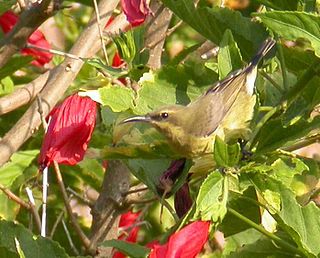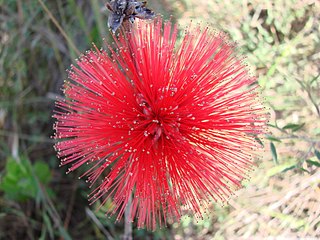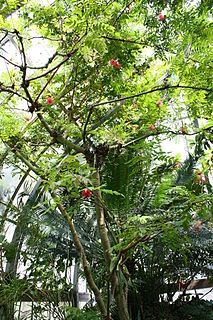
Calliandra is a genus of flowering plants in the pea family, Fabaceae, in the mimosoid clade of the subfamily Caesalpinioideae. It contains about 140 species that are native to tropical and subtropical regions of the Americas.
Alsophila decrescens, synonym Cyathea decrescens, is a species of tree fern endemic to Madagascar. The trunk is erect, 2–3 m tall and 10–12 cm in diameter. It usually has characteristic elliptical scars caused by fallen stipe bases. Fronds are bipinnate and 1–1.5 m long. The fronds may be densely pubescent and the lower pinnules are sometimes separated from the others as well as being reduced. The rachis and stipe are brown in colouration and bear narrow, dark brown scales. Sori are large, round and covered by fragile, brown indusia.

Calliandra eriophylla, commonly known as fairy duster, is a low spreading shrub which is native to deserts and arid grasslands in California, Arizona, New Mexico and Texas and Mexico.
Calliandra comosa is a species of plant in the family Fabaceae. It is found only in Jamaica.
Calliandra glyphoxylon is a species of plant in the family Fabaceae. It is found only in Ecuador. Its natural habitats are subtropical or tropical moist montane forests and subtropical or tropical dry shrubland.
Calliandra paniculata is a species of plant in the family Fabaceae. It is found only in Jamaica. It is threatened by habitat loss.
Calliandra pilosa is a species of legume in the family Fabaceae. It is found only in the country of Jamaica.
Calliandra tumbeziana is a species of plant in the family Fabaceae. It is found only in Peru.
Chloroleucon foliolosum is a tree species in the legume family (Fabaceae). It is found in Argentina, Brazil and Bolivia.

The copper sunbird is a species of passerine bird in the family Nectariniidae. It is native to tropical Africa, its range extending from Senegal and Guinea in the west to South Sudan and Kenya in the east, and southwards to Angola, Zambia, Zimbabwe and Mozambique.
Manilkara decrescens is a species of plant in the family Sapotaceae. It is endemic to Brazil, and is threatened by habitat loss.
Calliandra bella is a species of flowering plants of the genus Calliandra in family Fabaceae.
Calliandra conferta is a species of flowering plants of the genus Calliandra in the family Fabaceae.
Calliandra cruegeri is a species of flowering plants of the genus Calliandra in the family Fabaceae.

Calliandra dysantha is a species of flowering plants of the genus Calliandra in the family Fabaceae. Is native to Brazil.

Calliandra haematocephala is a species of flowering plants of the genus Calliandra in the family Fabaceae.

Calliandra houstoniana is a species of flowering plants of the genus Calliandra in the family Fabaceae.
Calliandra physocalyx is a species of flowering plants of the genus Calliandra in the family Fabaceae, endemic to southwestern Mexico. It is a shrub with pink-and-white or pink-and-red flowers. Like other members of the genus Calliandra, the filaments of the stamens are long and colourful, in this case about 7.5 centimetres (3.0 in) long. The species was first scientifically described in 1988.

Calliandra surinamensis is a low branching evergreen tropical shrub that is named after Suriname, a country in northern South America. The plant usually has complexly branched multiple trunks and grows to a height of about 5 metres, although many sources suggest that it only attains a height of 3 metres. Left unpruned it grows long thin branches that eventually droop down onto the ground. The leaves close and droop from dusk until morning when they once again reopen. Calliandra surinamensis is said to contain lectins which are toxic to cancer cells, although more research is needed. Calliandra surinamensis contains three important compounds: myrectin which contains antioxidant and anti-inflammatory properties, lupeol which contains anti-inflammatory and anti-cancer properties, and ferulic acid which contains antimicrobial properties.
Plotheia decrescens is a moth of the family Nolidae first described by Francis Walker in 1857. It is found in Sri Lanka.







